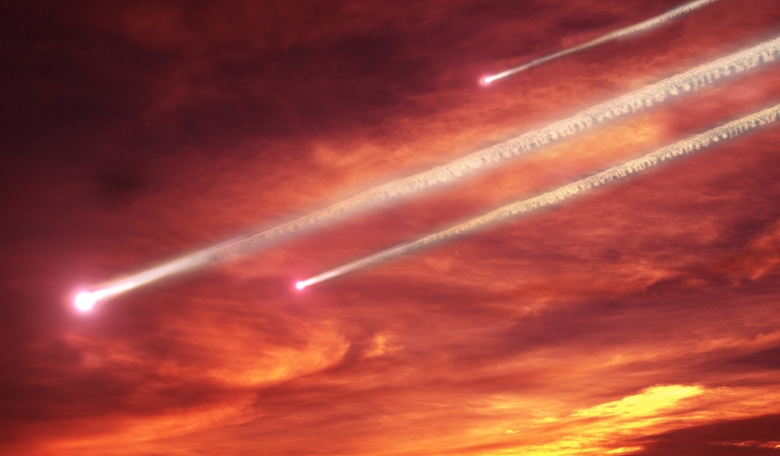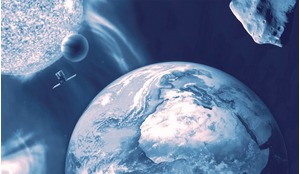One of the top priorities for any person on Earth is protecting their home. But though we can change our regular home a few times during a lifetime, we cannot move away from the Earth - we will not be able to leave our home in space, our spaceship, in the foreseeable future.
The bad news is that our ship has no steering wheel, no brakes and no sails. So, let’s look at protecting our planet Earth from the dangers originating in space and suggest some of the international legal groundwork that will help us provide this protection.
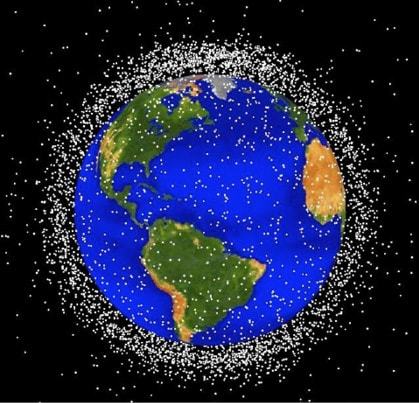 Low Earth orbit is the most concentrated area for orbital debris with approximately 95 per cent of objects shown here being orbital debris rather than functional satellites.
Low Earth orbit is the most concentrated area for orbital debris with approximately 95 per cent of objects shown here being orbital debris rather than functional satellites.
The threat from space is very real and typically when we talk about aerospace safety we start at the bottom - air defence and ballistic missile defence - before looking higher and higher, as far as the technological, financial capabilities and geopolitical concerns of the moment will allow us to go.
I would like to take the opposite approach and begin at the very top - in deep space. Perhaps a middle ground of aerospace defence can be found by defining the defence of planet Earth - because, in the face of a global space threat, all of our ‘intra-planetary geopolitical squabbles’ will simply disappear.
We are locked into a truly terrifying phase of space pollution as the space debris problem changes from being passive to aggressive
In seeking ways to protect Earth from military and non-military space danger I see international integration as a key factor that will help ensure mutual safety, and I am not just considering here purely astronautical issues but instead looking at space threats in a wider context.
The 21st century is not only the century when humanity has made unprecedented progress - but it will be defined as one of realising that our planet’s biosphere is fragile in the face of both man’s technological advances and natural disasters originating in space.
Among these, I categorise the following seven as the most dangerous threats:
- Solar storms and flares, known as coronal mass ejections.
- Changes in Earth’s magnetosphere which result in the destruction of the protective shield that could deflect coronal mass ejections.
- Potentially dangerous asteroids and comets, which could lead to mass destruction of humanity.
- Space debris created by humans.
- Climate change resulting from the effects of human activities and solar radiation on the Earth’s atmosphere.
- Cosmic rays from novas, supernovas and even pulsars.
- A potential danger of Earth being infected by microorganisms from inside meteors and other small celestial bodies that reach our planet’s surface.
The threats outlined above reminds one of Russian roulette - only with rocks, pieces of metal, solar energy and other surprises acting as bullets and putting all of humanity at serious risk.
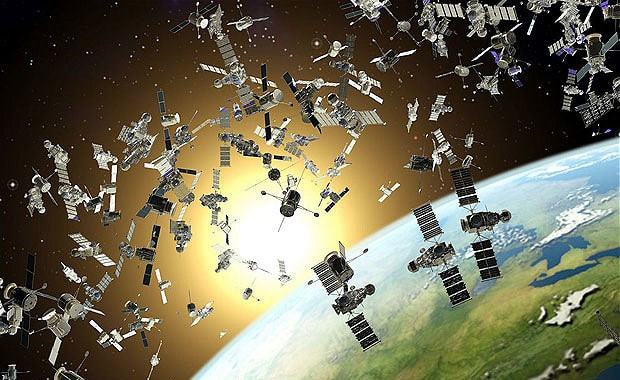 Graphical representation of the very real threat posed to Earth in debris terms by the proliferation of orbiting satellites.
Graphical representation of the very real threat posed to Earth in debris terms by the proliferation of orbiting satellites.
Let’s look in more detail at two of these points - space debris and the potential danger from asteroids and comets.
Space debris
The first decades of the Space Age brought not only new and unprecedented opportunities and technological, economical, military and social developments for humanity, but along with them the unavoidable negative consequences of near-Earth space exploration.
Potential conflict could be instigated by the sudden and unexpected break up of a spacecraft that plays an important role in a country’s defence
Ever since the first artificial satellite was launched into Earth orbit, there has been a systematic ecological change. The appearance and accumulation of man-made space debris - the quantity of which is continuing to multiply - presents an increasing danger to Earth’s population, a danger that has a number of defining characteristics.
There is a significant difference between man-made space debris and natural space debris (such as meteoroids). Meteors arrive unannounced from the depths of space, quickly pass through near-Earth space and mostly burn up in the lower atmosphere or, in rare cases, fragments reach the surface of Earth (as meteorites).
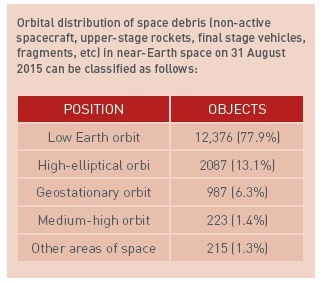
Man-made space objects (MSOs), however, having been launched from Earth into orbit, remain in orbit for a long time, creating a constant danger for active spacecraft and satellite vehicles.
The length of time that they remain in near-Earth space depends on orbital velocity and height - it can stretch to thousands or even millions of years in the case of geostationary MSOs, for instance. This constant accumulation of debris in space has long been underestimated.
As of 31 August 2015, the total number of man-made space objects that remain in space and have been listed by the automatic warning system for dangerous situations in near-Earth space was 17,250. Of these, 1,362 space objects are active spacecraft and satellites, whereas 15,888 are man-made space debris (MSD), including: 2682 non-active spacecraft, 1907 upper-stage rockets and final stage vehicles, and 11,299 fragments of spacecraft, upper-stage rockets, final stage vehicles and other elements.
Of the currently operational spacecraft (active, reserve, undergoing testing or partially active), most belong to the USA (446), Russia (135) and China (132). Orbital distribution of space debris (non-active spacecraft, upper-stage rockets, final stage vehicles, fragments, etc) in near-Earth space on 31 August 2015 can be classified as in the table.
The main danger posed by space debris is the collision cascade effect (known as the Kessler syndrome) - a rapidly developing chain reaction caused by an increasing number of space debris collisions in near-Earth space.
Today we are locked into a truly terrifying phase of space pollution as the space debris problem changes from being passive to aggressive. According to some analysts, the cascading effect of smaller space debris has already begun in low Earth orbit. The logical conclusion is that the cascading effect will lead to near-Earth space becoming virtually useless for scientific research, commercial, military and other uses.
Information and data on the location of space debris is now highly relevant when planning near-Earth space missions and the ‘space debris’ factor is playing an increasingly important role from the point of view of state national security.
It is not hard to envisage how space debris ‘situations’ could become a pretext for wide-scale military operations against the space capabilities of a potential opponent - should they be interpreted as a violation of rights, technical facilities or freedom of operations in space. Space debris also provides a convenient excuse for covering up targeted actions taken against an opponent’s spacecraft using, for example, another Earth orbiting satellite.
All this means that demonstrated situational awareness on the state of things in space - which is defined first and foremost by knowledge of space debris - is a powerful deterrent against hostile actions.
An example instigating potential conflict would be the sudden and unexpected break up of a spacecraft that plays an important role in a country’s defence. In the absence of corroborating observational data, such an event could be interpreted as purposeful action by another party.
This problem has a long history and deserves a special review, as it is closely connected with the accelerated development of technology and the possibility of using small satellites as kinetic kill vehicles against a potential enemy. These circumstances point to the fact that the space debris issue is a pressing one.
Because of this, future and peaceful space exploration is especially important, as is the provision of long-term space activities in ‘polluted’ near-Earth space, which concerns the entire international community.
Asteroids and comets
The danger posed by asteroids and comets was scientifically accepted by the end of the 20th century. A collision with a celestial body of a few kilometres in diameter has the potential to completely destroy our civilisation, or at least retard its development by many centuries.
Based on the size, speed and other parameters of asteroids and comet nuclei, their collision with Earth can lead to global, regional and local catastrophes.
 Meteor Crater, the world’s best preserved meteorite impact site on Earth in Northern Arizona, USA. It is almost one mile across, 2.4 miles in circumference and more than 550 feet deep.
Meteor Crater, the world’s best preserved meteorite impact site on Earth in Northern Arizona, USA. It is almost one mile across, 2.4 miles in circumference and more than 550 feet deep.
Bodies of tens or hundreds of metres in diameter that fall into an ocean can cause a tsunami that would destroy coastal settlements, while those that fall on land may easily destroy a large city or an entire country, disrupt telecommunications, energy and other systems, destroy nuclear facilities, chemical plants and toxic waste depositories, etc.
This is why the issue is being addressed increasingly by scientists, public and government agencies in many countries, as well as by international organisations such as the United Nations, the Parliamentary Assembly of the Council of Europe, and the Organisation for Economic Cooperation and Development.
An impact on Earth could become the trigger for a global ecological crisis or even military conflict
Since asteroids and comets present one of the most serious and potentially hazardous dangers to our civilisation, development of countermeasures must become one of the most important tasks for humanity in the 21st century.
Catastrophes
Over the last 600 million years there have been about 60 collisions identifiable with celestial bodies of over 5 km in diameter, all of which have led to global catastrophes of one kind or another. According to some theories, the great Biblical flood could have been a consequence of a celestial body collision and the consequent tsunami.
One of the most significant events happened 65 million years ago around the Yucatan peninsula as a result of the entry of a celestial body with a diameter of about 10 km which formed the 180 km diameter Chicxulub crater. This collision caused the extinction of 75 per cent of Earth’s flora and fauna, including dinosaurs.
Collisions with objects whose diameters range from hundreds of kilometres to a few metres across - which happen on average anywhere from every few decades to a few thousand years - lead to regional catastrophes.
One of these occurred 12,900 years ago, when a comet nucleus a few kilometres in diameter exploded over North America. As a result of this explosion, the continent’s biosphere was scorched and the ancient Clovis civilisation was destroyed.
Impact zones in these cases may exceed the size of the largest megalopolises in the world, or even that of small countries. The Arizona and Tunguska meteorites are examples of such events.
The Barringer crater, for example, is located in the state of Arizona and has a diameter of 1.3 km and is 170 m deep. It was formed about 50,000 years ago by the impact of an iron and nickel asteroid of about 40-60 m in diameter and weighing about 300 thousand tonnes.
Energy output from the Tunguska meteorite explosion over the Siberian taiga on 30 June 1908 was between 10 and 100 megatons. It laid waste the forest across a 2000 square km area (twice the size of Moscow), as well as triggering fires in the taiga that raged for almost two years.
Impacts
In the last 100 years, four celestial bodies with diameters of 40-60 m have impacted Earth, all on land. If one takes into account the ocean masses as well, collisions with Earth happen on average every decade whilst explosions of up to one mega tonne in the upper atmosphere happen almost monthly.
The impact of such celestial bodies on military or civil nuclear facilities, chemical plants, toxic waste depositories, etc, can lead to not only major casualties and material losses but could also trigger a global ecological crisis or even military conflict.
There have already been five notable events related to the impact of celestial bodies since the beginning of the 21st century:
5 July 2002 - explosion of a large fireball in the sky near Dnepropetrovsk, Ukraine, which was initially mistakenly interpreted as a passenger plane being shot down by a surface-to-air missile.
24 September 2002 - a 0.2 megatonne explosion in the Vitim river basin, Siberia, when about 100 sq km of taiga was demolished.
28 September 2003 - Indian village of Sudusudya was burnt down as result of the impact of large fireball fragments, leaving one dead and 20 injured.
7 June 2006 - explosion in the Norwegian mountains, comparable in power to the atomic bomb dropped on Hiroshima.
15 September 2007 - explosion by the village of Carancas, Peru, forming a 30 m diameter and 6 m deep crater.
15 February 2013 - the 20 m Chelyabinsk meteorite that fell in Russia led to significant damage and wounded about 1500. If it had entered the atmosphere at a sharper angle or travelled for a fraction of a second longer, instead of exploding at a height of 25 km it would have exploded in immediate proximity to the Earth by the city of Chelyabinsk and would have become one of the greatest catastrophes of modern times.
Asteroids and comets present a silent and serious danger to our civilization because at any point they may bring a catastrophe ranging from something local to one on a global scale.
To be acceptable to governments around the globe it must be an international platform with completely transparent intellectual property rights and open architecture
And now, a few words about military threats in aerospace. The good news is that these are the threats that we humans are responsible for ourselves. The bad news is that never during the entire history of our existence have we been able to fully control these threats that we ourselves create on our own planet.
We first took the military arena into the skies more than a century ago when we began using dirigibles to drop bombs. Today’s challenge is to ensure that humanity does not carry its military conflicts over into space itself.
In May, as part of a keynote address at the 4th Manfred Lachs International Conference on Conflicts in Space and the Rule of Law in Montreal, Canada, I proposed that nations consider co-operating to build a defensive space station capable of tackling both natural and man-made threats to the planet.
A Universal Robotic Battle Cosmic Platform (URBOCOP) would be an armed, unmanned space station capable of monitoring both Earth and space. It would have an onboard defensive weapon systems capable of destroying both natural and man-made objects threatening Earth - including ballistic missiles launched by one national against another. The control system would be entirely automatic and free from human bias, allowing it to make decisions about striking dangerous military launches, regardless of their country of origin.
To be acceptable to governments around the globe it must be an international platform with completely transparent intellectual property rights and open architecture. Funding and the right to use it must belong to all mankind - encompassing advanced nations and developing countries alike, with no restrictions or boundaries.
This kind of defensive platform will require a new approach to international politics which I term ‘astropolitics’, something which would need to encompass not just major aspects of international relationships but legal matters on a much more human scale, including, for example, defining who would be responsible for trying, convicting and punishing someone who, for example, committed a murder in space for the first time in history.
Let me emphasise that what I am suggesting now just a concept - the potential to create some kind of orbital system that could one day protect planet Earth from space threats as well as from our own military misdemeanours. A space outpost such as my proposal for URBOCOP could one day protect our planet from both outer space threats and from those who seek to disturb the peace on Earth.
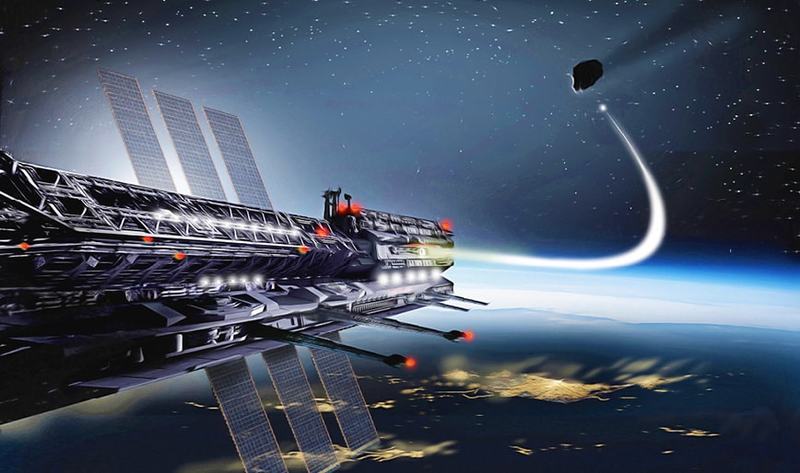 An artistic vision of the proposal for a monitoring and defence platform called URBOCOP in Earth orbit.
An artistic vision of the proposal for a monitoring and defence platform called URBOCOP in Earth orbit.
In order to create an effective form of protection against space risks, it’s necessary to ensure close international cooperation. Any unilateral action by a single country, even the richest or the most technologically advanced, can encounter multiple legal, political and strategic barriers.
However, in my opinion, there is currently no unified, global, international expert and legal entity that could be have the final say in these matters. And that is very dangerous. It is dangerous to bring our ancient and very real earthly squabbles to space, and international space law must not become a ‘rule of force’ in our earthly understanding.
The right to space and its resources must belong to our entire small world - all seven to eight billion people, who have been artificially divided into two hundred or so countries, varied in military and financial ability. No matter how idealistic that may sound to us today, they must all have equal opportunity to protect our common planet and equal opportunities to explore new worlds.
Igor Ashurbeyli is a scientist and a visionary, holding a PhD in Computer Science and Engineering. He founded Socium in 1988 - originally a small software and consulting company, now a large holding with over 8,000 employees in 30 companies worldwide - and the Aerospace International Research Center (AIRC) in Vienna in 2013. He is owner and Editor-in-Chief of ROOM - The Space Journal.





